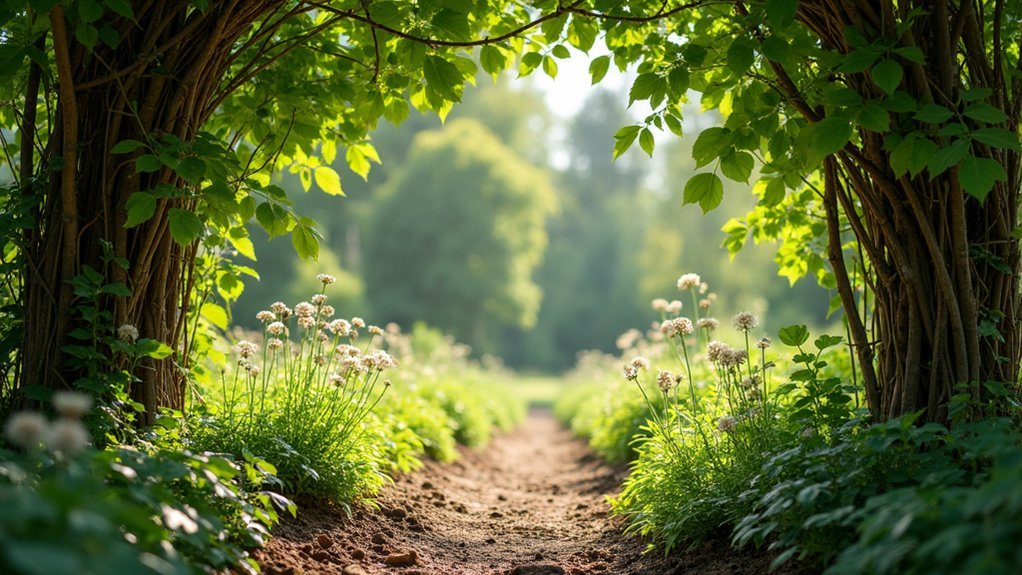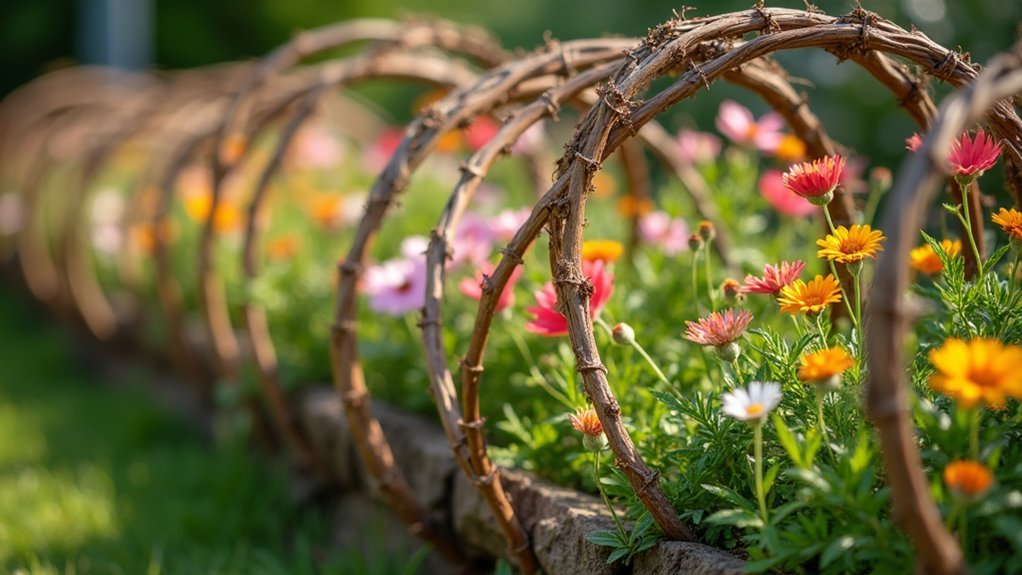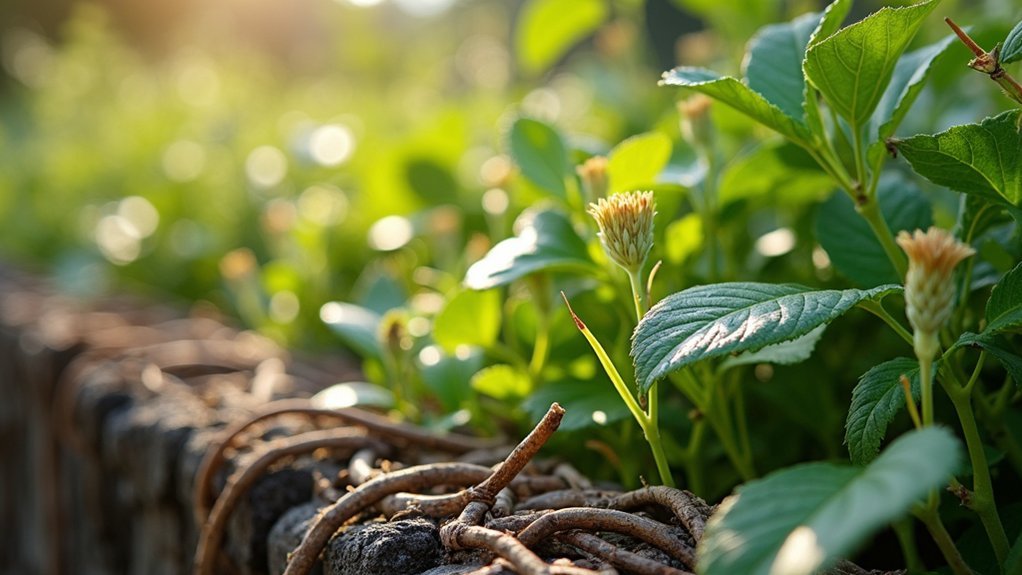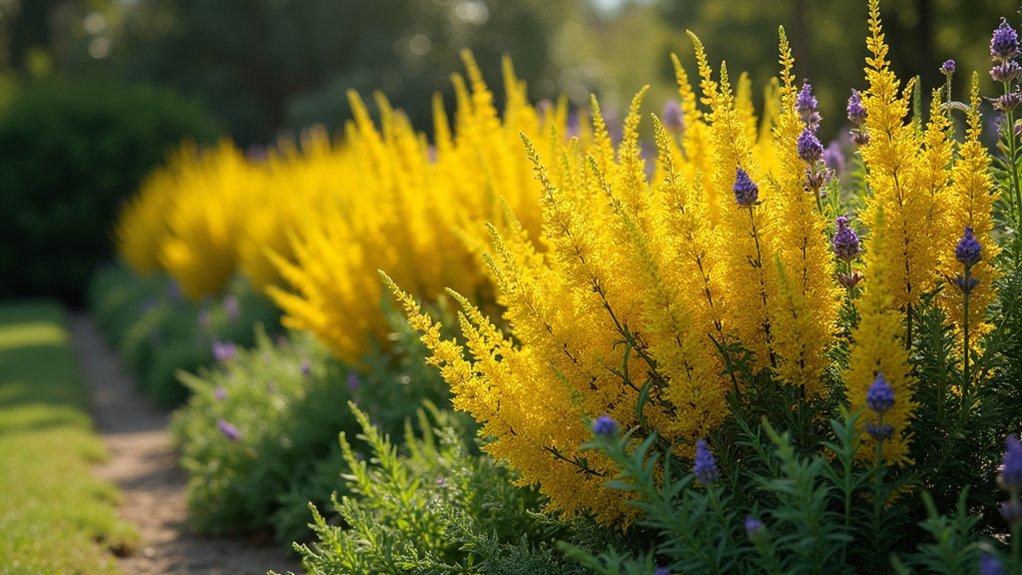Wattle garden borders blend medieval heritage with timeless elegance, offering natural beauty and practical benefits for your garden. These woven barriers provide superior airflow around plants while creating rustic charm that enhances any landscape style. You’ll need flexible willow or hazel branches, stakes, and basic tools to craft these sustainable edges that require no nails or hardware. Beyond their aesthetic appeal, these eco-friendly borders support biodiversity and can be customized to complement various planting schemes and garden designs.
The Heritage and Charm of Wattle Garden Borders

Intertwining traditions of practicality and beauty, wattle garden borders have graced landscapes since medieval times.
What began as simple barriers to protect precious plants from rabbits and other pests has evolved into an artform that brings rustic elegance to any garden setting.
You’ll find these woven wonders throughout history—from Victorian England, where specialized craftsmen created movable hurdles, to present-day European gardens where they’re still valued for their cost-effectiveness and natural appeal.
The timeless charm of wattle fencing lies in its ability to blend with surrounding vegetation, offering visual interest even during winter months. Harvested traditionally in February month, the flexible willow shoots provide ideal material for creating these distinctive garden elements.
When you incorporate wattle borders into your garden, you’re not just adding a fence—you’re connecting with centuries of horticultural heritage while embracing sustainable, locally-sourced materials that complement nature’s own design.
Essential Materials and Tools for Wattle Weaving
You’ll need flexible, freshly-cut willow branches measuring under 1″ in diameter for weaving your wattle border, with thicker 1.5″ stakes for structural support.
Sharp pruners or a silky saw will give you clean cuts while preventing splitting, especially when tapering the ends of your stakes for easier ground insertion.
Harvest your materials during late winter or early spring when the sap is rising to guarantee maximum pliability and reduced breakage during the weaving process. Consider alternative materials like bamboo, hazel, or Bull Pine if willow is unavailable, as these provide similar pliable options for traditional wattle construction.
Willow Branch Selection
Selecting the right willow branches is the cornerstone of successful wattle weaving. Common hazel and willow varieties are prized for their flexibility and durability when creating garden borders. Look for newly cut, green wood as it’s considerably easier to manipulate during the weaving process.
You’ll want to choose supple branches from species like sweet chestnut, plum, or forsythia if willow isn’t available. When harvesting, sort branches by size and straightness to simplify your work later. Hardwood trees typically produce overly stiff materials that resist the weaving techniques required for wattle fencing.
If you’re using dried willow, soak it thoroughly in water to restore its pliability before weaving.
Remember that willow stems regenerate after harvesting, making them a sustainable choice for your garden projects. For a cleaner finish, trim side shoots with secateurs; alternatively, leave them intact for a more rustic, natural appearance.
Pruners and Stakes
To create a proper wattle border, you’ll need two essential components: reliable tools and sturdy stakes. Arm yourself with sharp pruners for cutting smaller saplings and loppers for thicker branches. A hammer will help secure stakes firmly into the ground, while a tape measure guarantees even spacing along your planned border line.
For stakes, select straight, durable woods that resist rot. Hazel, bull pine, sweet chestnut, plum, and forsythia all make excellent choices. Your stakes must be sufficiently tall and sturdy to support your fence’s intended height. Small, straight pieces of any wood species can work well for these support posts.
Plant them at regular intervals, using an odd number of stakes to facilitate the weaving pattern. Remember that the first and last stakes establish your foundation, so drive them deeply into the soil for maximum stability and a professional-looking finish.
Step-by-Step Guide to Crafting Your First Wattle Border

You’ll need fresh brushwood, saplings, and simple tools like pruners to create your wattle border effectively.
Start by sorting your materials into stakes (1 1/2″ or larger) and weavers (1″ or less). Then position your stakes in the ground at 16-18 inch intervals.
When weaving, work with one sapling at a time, alternating on each side of the stakes while maintaining consistent tension for structural integrity. Digging a small trench for posts will ensure they sit deep enough in the soil for proper stability.
Materials and Tools
The foundation of a successful wattle border begins with proper materials and tools.
You’ll need flexible woody stems like hazel, willow, dogwood, or birch that are 1/2″-1″ thick for weaving. For stakes, choose sturdier wood like oak or treated pine at 1.5″-2″ thick.
Essential tools include pruning shears or a handsaw for cutting branches, a rubber mallet for driving stakes, and protective gloves to prevent splinters.
A tape measure helps maintain consistent 12″ spacing between stakes.
For materials, harvest branches during dormancy (late fall to early spring) when they’re most flexible.
Consider using invasive species like buckthorn for an eco-friendly approach. You can forage materials for free or purchase pre-cut rods from garden centers at $3-$5 per linear foot.
Quality clippers are vital to the project, with Falco brand being particularly recommended for clean, efficient cuts.
Weaving Basics
Now that you’ve gathered the right materials and tools, creating your first wattle border involves strategic preparation and methodical weaving.
Begin by marking your border with string to visualize the fence line, ensuring you’ve checked for underground utilities and roots.
Install your stakes 12-18 inches apart (closer for curves), driving them at least 6 inches into the soil. For a more organic look, consider creating a meandering curve rather than straight lines. Always use an odd number of stakes to maintain a stable weaving pattern.
The weaving process follows these key principles:
- Start weaving from the second stake inward to prevent unraveling
- Alternate each rod front-to-back between stakes for strength
- Press downward firmly when adding each new layer
- Overlap new rods by 3-4 stakes when extending your weave
Seasonal Considerations for Wattle Border Installation
When planning your wattle border installation, timing matters greatly for both material gathering and construction success. Winter and early spring offer ideal conditions for collecting willow and hazel branches when they’re most pliable for weaving.
Harvest branches in winter or early spring when nature provides the perfect weaving flexibility for your wattle border.
If you’ve missed these seasons, simply soak dry branches in water for a few hours to restore flexibility.
Before installation, thoroughly clear your site of weeds and debris. Choose a location with good drainage, adequate sunlight, and enough space for plants to grow alongside your border.
Use string and measuring tape to guarantee evenly spaced stakes. This traditional technique creates fencing that provides better airflow around your garden plants, preventing damaging wind tunnels.
Throughout the year, inspect your wattle border for loose withies or leaning stakes. Keep extra matching branches on hand for repairs, and consider applying natural wood preservatives to extend the life of your beautiful garden feature.
Extending the Lifespan of Your Woven Garden Edge

Careful maintenance represents the key difference between a wattle border that lasts two seasons and one that beautifully frames your garden for five years or more.
The natural materials used in wattle borders, while eco-friendly, require thoughtful protection against environmental elements.
To maximize your border’s durability:
- Apply protective treatments – Use natural oils or preservatives annually to create moisture resistance and prevent rot.
- Install strategic supports – Place discreet stakes or supports to maintain the border’s structure during seasonal changes.
- Create environmental shields – Position borders to minimize direct sun exposure and excessive moisture contact.
- Perform seasonal inspections – Check regularly for damage and make immediate repairs before minor issues become structural failures.
Regular reapplication of protective coatings is especially important in humid climates where natural materials deteriorate more quickly. Unlike stone garden walls which can last for decades without rotting, wattle borders require more frequent maintenance as they lack the durability of stone that makes stone walls so long-lasting.
Creative Design Variations for Different Garden Styles
Wattle borders, with their versatile and adaptable nature, offer endless possibilities for customizing your garden’s aesthetic regardless of your preferred style. You’ll find these natural woven edges complement everything from traditional colonial gardens to modern minimalist spaces. The sustainable construction requires no nails and promotes an eco-friendly approach to garden design.
| Garden Style | Wattle Characteristics | Materials | Complementary Features |
|---|---|---|---|
| Colonial/Cottage | 12″ tall, rustic weave | Hazel, willow branches | Native perennials, herbs |
| Modern Minimalist | Thin, delicate weaves | Combined with metal | Clean lines, white/green plants |
| Raised/Urban | Modular, structured | Stakes 12″ apart | Fills hardscape gaps, balcony-friendly |
| Naturalistic | Irregular, layered | Partially decaying natural twigs | Wildflowers, wildlife habitats |
For artistic gardens, consider asymmetrical weaving heights for visual storytelling, perfect for fantasy-themed spaces that evoke storybook charm like “The Shire.”
Complementary Plantings That Enhance Wattle Aesthetics

Selecting the right plants to accompany your wattle borders transforms them from simple garden edging into living, dynamic features that enhance your entire landscape. Native Australian choices like Grevillea paired with lilly pillies or Dianella create ecological harmony while attracting beneficial pollinators such as blue banded bees.
For maximum impact with your wattle borders, consider:
- Weaving flexible willow stems through your wattle framework for structural interest and rustic charm.
- Planting low-maintenance, drought-tolerant species that won’t overshadow the wattle’s natural beauty.
- Including pest-repellent plants like rosemary or sage to protect nearby vegetables.
- Creating textural contrasts by combining smooth wattle with varied plant textures for visual depth.
These thoughtful combinations guarantee your wattle borders remain beautiful while contributing to a balanced, healthy garden ecosystem. Allow your newly constructed wattle structure to sit for 1 to 2 weeks before planting nearby, giving branches time to properly dry and settle.
Modern Adaptations of Traditional Wattle Techniques
Though centuries old in origin, traditional wattle techniques have undergone remarkable evolution to meet contemporary gardening and construction needs while preserving their distinctive charm.
You’ll find prefabricated wattle panels that offer faster installation while maintaining the classic latticed appearance.
Today’s wattle incorporates alternative materials beyond traditional willow and hazel, including recycled composites and durable synthetic options that extend longevity.
Modern wattle embraces innovation through recycled composites and synthetics while honoring its traditional roots and extending its practical lifespan.
These innovations don’t sacrifice the sustainable principles that make wattle appealing—they enhance them.
Modern adaptations often integrate with other building systems, creating hybrid structures with superior insulation and stability. The eco-friendly nature of wattle construction addresses energy efficiency concerns in modern sustainable architecture.
For your garden borders, these updated techniques mean you can enjoy the aesthetic appeal of historical wattle with improved durability and reduced maintenance, all while supporting environmentally conscious landscaping practices.
Frequently Asked Questions
Can Wattle Borders Deter Small Animals From Garden Beds?
Yes, wattle borders can deter small animals from your garden beds. Their dense, thorny structure creates a physical barrier that’s difficult for rabbits and rodents to penetrate, though you’ll need regular maintenance for continued effectiveness.
Are There Non-Wood Alternatives for Creating Wattle-Style Borders?
Yes, you can create wattle-style borders without wood. Consider recycled plastic edging, metal forms, bamboo, straw wattles, or PVC pipes. These alternatives offer similar aesthetics with varying durability and sustainability benefits.
How Does Soil Type Affect Wattle Border Stability?
Your wattle border’s stability depends heavily on soil type. Well-draining, firm soil supports stakes effectively, while waterlogged or overly sandy soil can cause instability through rot or insufficient stake anchoring.
Can Wattle Borders Be Painted or Stained?
Yes, you can paint or stain wattle borders. Natural versions accept wood stains or outdoor paints after proper drying, while aluminum wattle borders actually benefit from painting or powder-coating for protection and customization.
Is Permit Approval Needed for Installing Tall Wattle Fencing?
You’ll likely need a permit for wattle fencing over 6 feet tall. Check your local zoning regulations, as height restrictions vary by location. Detailed plans and possibly a boundary survey are often required for approval.
In Summary
By embracing wattle borders, you’re connecting with centuries of gardening tradition while adding natural elegance to your outdoor space. They’ll transform your garden with minimal expense and environmental impact. Whether you’ve chosen classic designs or modern adaptations, your woven edges will mature beautifully alongside your plantings. With proper maintenance, you’ll enjoy these rustic boundaries for years to come—a demonstration of timeless craftsmanship in your contemporary garden.





Leave a Reply